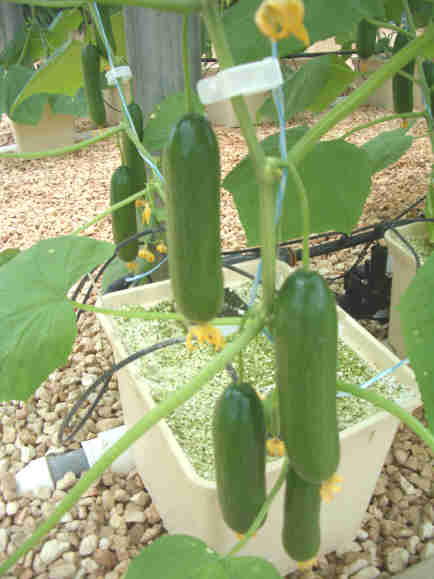Hydroponic Bucket System
You are on Page 4 of our ten page series on hydroponic bucket systems. Click on any of the below pages to jump to that page.
Page 1 Page 2 Page 3 Page 4 Page 5 Page 6 Page 7 Page 8 Page 9 Page 10

Hydroponic cucumbers in a bucket system. This particular system is described in much more detail at the HowardResh.com website. Howard Resh is one of the founding fathers of modern hydroponic production for both hobby and commercial growers. His cucumber page provides extensive details about raising this crop in a bucket system; his website offers detailed information on a variety of vegetable crops. We offer a variety of Howard Resh's books in our Hydroponic Books section.
Which Crops Work In The Bucket System?
Hypothetically, any plant can be grown in a bucket system. The main criteria would be the size of the plant compared to the size of the bucket. Sizing the bucket to the plant helps ensure an optimal setup. Even trees can be grown in bucket systems if the buckets are large enough. More common hydroponic crops such as lettuces can also very successfully be grown in buckets. In that instance, standard hydroponic buckets can be used for anything from single large head-type lettuces, four to six loose-leaf lettuce types grown to full size, up to sixteen very densely planted lettuces intended for mesclun production or cut-and-come-again harvesting.
Many herbs can also successfully be grown in buckets, with all the same variations listed above for lettuces. Sage, oregano, thyme, tarragon and other herbs can be grown very nicely in buckets as long as the number and/or size of the plant(s) is/are matched well with the size of the bucket. The bucket system works particularly well for those aggressive herbs which tend to invade planting beds, such as anything in the mint family. The buckets will keep them contained while offering all the other advantages we’ve already discussed.
Small vining plants such as peas and beans could do very nicely in bucket systems, as long as they are given trellises to climb. Standard-sized buckets could be planted fairly densely in each bucket, sprouted directly in the bucket, and then trained up a trellis as they grow. As we saw with small grains, the size of the bucket wouldn’t be an issue but choosing a suitable growing media would be critical. Also with peas and beans, the plants would benefit from soil inoculants just like in conventional farming and gardening. While the nutrient solution delivers a steady stream of nutrients, the plants themselves have come to depend on the symbiotic relationship with inoculants, which provides benefits which go well beyond nutrient delivery. That relationship can be preserved in hydroponics. Any growing media which can support sprouting conditions can support inoculants.
Root crops could potentially be grown in the bucket system, as long as the buckets are physically deep enough to provide for proper root development. In that instance, not only would the grower need to carefully size the buckets to the crop, but he/she would also need to carefully select which growing media to use. Carrots, the onion family, radishes, etc can all be grown in buckets as long as those roots have the depth and the growing media which allows for root length and mature diameter.
Small grains could conceivably be grown in buckets if the grower wanted frequent, small batches. For instance, a homesteading environment where the family wanted weekly harvests of wheat, rye or barley to be milled into fresh flour and used immediately. In this instance, a series of buckets would be laid out and planted a little at a time, such that grains grow and ripen on a staggered schedule. This approach also assumes that the grains are being grown in a controlled atmosphere environment such as a greenhouse, or that the growing season is very long and stable. Still, it is an option for growers who would rather not have a big batch of grains ripening all at once. The bucket size/depth wouldn’t be quite so important here as it would be for root crops. However, the grower would need to give extremely careful attention to the growing media, since small grains generally are not transplanted. They would have to be planted, sprouted, grown and harvested all in the same container. Doable with careful setup.
All the above can potentially be grown in buckets. Realistically though, the plants most often grown in bucket systems are large vines, including tomatoes, cucumbers, squash, melons and similar. Why is this the case? This is due partly to the fact that other production systems work better for other plants. For instance, flood and drain systems and NFT systems work wonders with salad greens and herbs, and are usually more cost effective than other approaches. Another part of the equation is that other systems don’t work particularly well with the large vining plants. NFT channels don’t provide enough root zone size, and the raised flood and drain containers make reaching the fruits difficult. Deep water culture systems would have trouble supporting the weight of large mature vining plants, let along provide easy access to the fruit. So the bato bucket is a good match for vining plants.
Another set of crops which work well in bucket systems are large herb plants, particularly large perennials such as lavender and rosemary. Both of these can get very large over the years, and would eventually overwhelm other hydroponic growing systems. The bato bucket can be sized to accommodate the mature plants, while providing optimized nutrient delivery. Old or diseased plants can easily be removed, and new plants easily brought in. No other hydroponic system offers those advantages.
BACK NEXT
Click any of the following links to jump to that page:
Page 1 Page 2 Page 3 Page 4 Page 5 Page 6 Page 7 Page 8 Page 9 Page 10